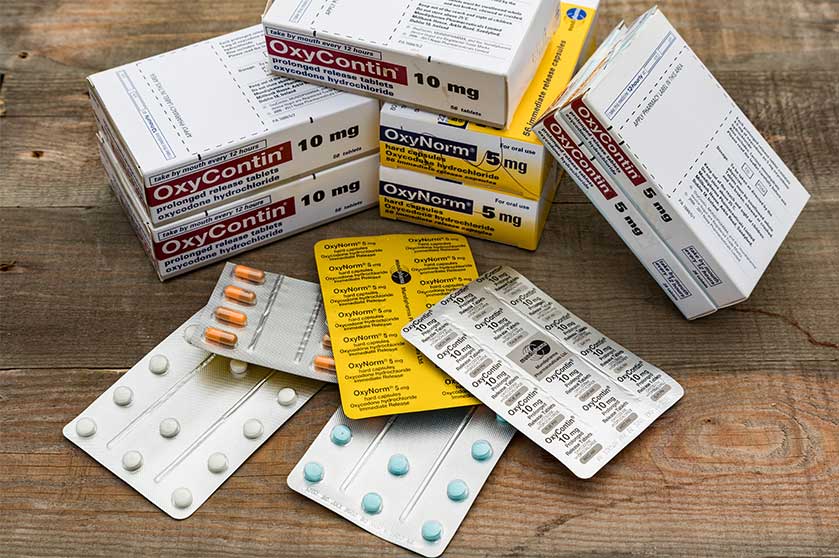Plugging OxyContin | Dangers Of Rectal OxyContin Use

Medically Reviewed By: Manish Mishra, MBBS

Written by: Dr Jason Martin Psy.D., LCPC
Plugging OxyContin involves crushing the opioid tablet into a powder and combining it with liquid. The drug is then inserted into the rectum, resulting in heightened sedation. There are numerous effects and dangers of rectal oxycodone use, including an increased risk of overdose.

OxyContin (the brand name for oxycodone) is an opioid analgesic prescription drug available as an immediate-release or extended-release tablet used to help treat those suffering from severe pain.
Some who abuse this painkiller may crush the OxyContin tablet, combine the powder with liquid, and insert the drug into their rectum, a process known as “plugging.”
Those who participate in plugging OxyContin (also known as simply “oxy”) may suffer from severe side effects and have an increased risk of an opioid overdose.
OxyContin is a Schedule II controlled substance according to the United States Drug Enforcement Administration (DEA), which means it has a high potential for abuse and can lead to physical dependence.
Effects Of Plugging OxyContin
The use of oxycodone targets opioid receptors in the brain and acts as a central nervous system (CNS) depressant. This provides pain relief but creates side effects such as sedation.
Those plugging OxyContin may experience a variety of side effects depending on the severity of drug abuse. These effects may come on strong once the drug enters the bloodstream via the rectum.
Common Side Effects
Some of the common side effects of OxyContin, per the United States Food and Drug Administration (FDA), may consist of:
- sedation
- drowsiness
- constipation
- headache
- dizziness
- dry mouth
Any of these side effects can be drastically increased when OxyContin is used rectally.
Withdrawal Symptoms
Those with an opioid addiction who engage in plugging OxyContin may experience more severe withdrawal symptoms due to the high concentration of the substance that enters the body so quickly. Some of these may include:
- sweating
- vomiting
- muscle pain
- nausea
- diarrhea
- anxiety or depression
- fast heart rate
- sleeping problems
- dehydration
Not only can a person experience these side effects, plugging OxyContin may also provide more bodily harm and create numerous dangers which can impact your health.
Dangers Of Plugging OxyContin
Taking large doses of OxyContin, snorting the drug, smoking, or injecting the opioid can result in a number of health problems. Plugging OxyContin may lead to more intense effects as well as potential health risks.
Rectal Infections
Plugging OxyContin may result in tears of the mucous membranes of the anus. Bleeding can occur due to the irritation of the anal walls.
Those who share needles or syringes may develop bacterial infections or serious diseases which can lead to hepatitis or HIV.
Drug Interactions
Those who take certain medications and participate in rectal OxyContin use may have an increased risk of overdose or life-threatening health problems. Those participating in opioid abuse should avoid the following:
- antihistamines
- benzodiazepines
- antidepressants
- alcohol
- over-the-counter pain relievers
- medications containing opioids such as Percocet, hydrocodone, codeine
- illicit drugs including fentanyl
OxyContin Overdose
Plugging OxyContin may increase the risk of overdose death. A high dose of the prescription opioid in your system may lead to an OxyContin overdose.
Symptoms of an overdose may include:
- respiratory depression
- change in pupil size
- clammy skin
- extreme sleepiness
- weakness
- coma
Those taken to the hospital may have medications such as methadone or naltrexone administered by a doctor. These meds help to reverse the effects of an opioid overdose.
For those living with opioid drug addiction, please contact Ohio Recovery Center for information on our inpatient substance abuse treatment options.
- Centers for Disease Control and Prevention — Understanding Drug Overdoses and Deaths https://www.cdc.gov/drugoverdose/epidemic/index.html
- Dove Medical Press: Therapeutics and Clinical Risk Management — The controversy surrounding OxyContin abuse: issues and solutions https://www.ncbi.nlm.nih.gov/pmc/articles/PMC1661612/
- Drug Enforcement Administration — Oxycodone https://www.dea.gov/sites/default/files/2020-06/Oxycodone-2020_0.pdf
- Food and Drug Administration — OxyContin https://www.accessdata.fda.gov/drugsatfda_docs/label/2021/022272s046lbl.pdf
- PLoS One — Meta-analysis of efficacy and safety of sustained release oxycodone hydrochloride rectal administration for moderate to severe pain https://www.ncbi.nlm.nih.gov/pmc/articles/PMC9236234/

